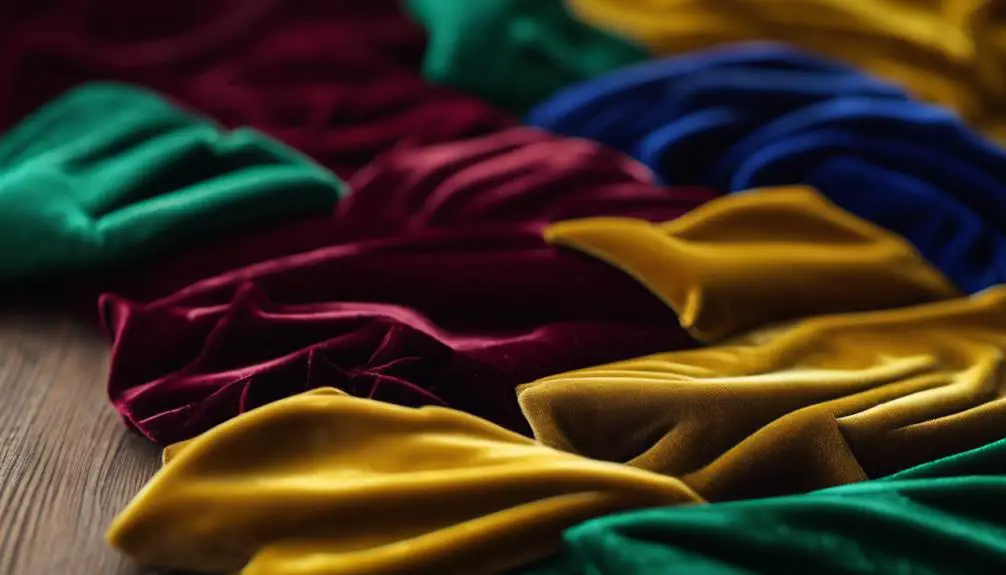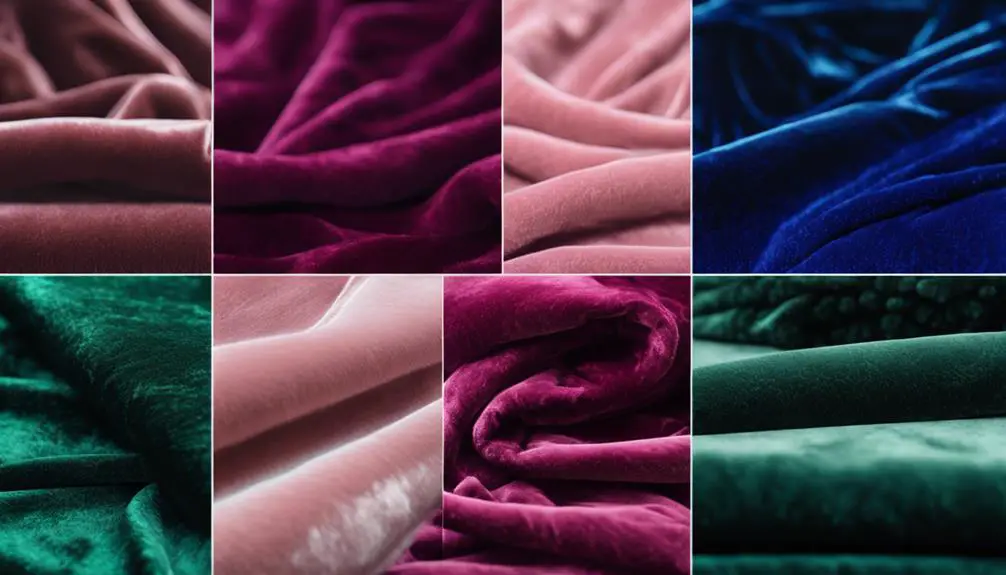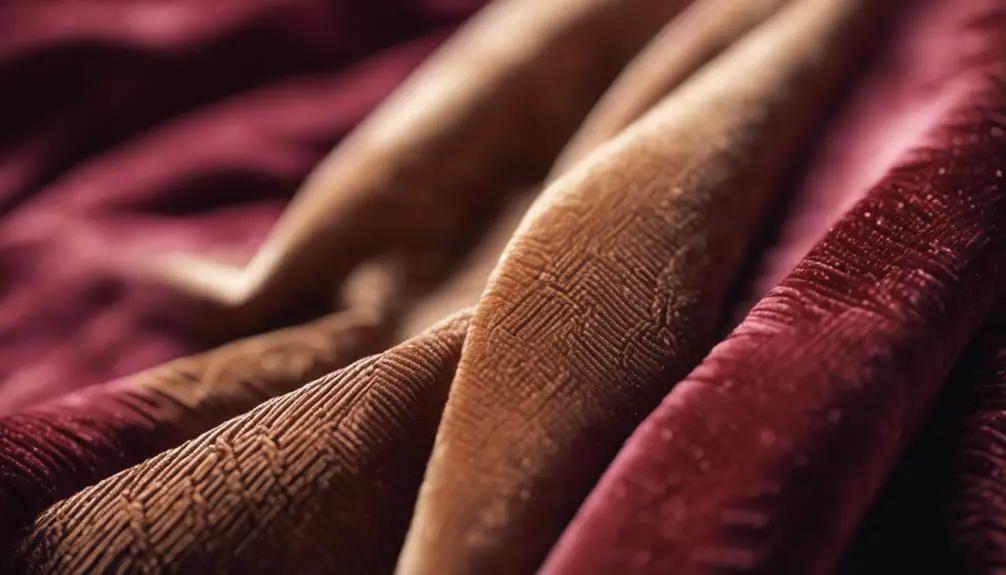To identify velvet, start by feeling its texture; it should have a soft, luxurious pile that feels dense yet smooth. Check the weight, as quality velvet is typically heavier than other fabrics. Observe the shiny surface, which reflects light due to its unique nap. You might notice the nap changes direction, altering the fabric's appearance. Pay attention to color consistency—high-quality velvet shouldn't show fading or spots. If you encounter silk velvet, it's even softer and heavier, with a distinctive sheen. Curious about the different types and uses of velvet? There's plenty more to explore.
Understanding Velvet Characteristics

The allure of velvet lies in its unique characteristics that set it apart from other fabrics. You'll quickly notice velvet's soft surface, created by a dense pile that stands upright, giving it a luxurious feel. This plush texture invites you to touch it, making it a favorite for garments and home decor alike. The shiny appearance of velvet is another standout feature, thanks to its distinctive nap that reflects light differently based on the pile's direction.
When identifying velvet, consider the types of velvet available, like silk velvet and cotton velvet. Silk velvet boasts a rich texture, while cotton velvet is more durable and easier to care for. Both types showcase velvet's non-stretching quality, which allows for excellent drape in a variety of applications.
As you explore different fabrics, remember that velvet has a thicker structure compared to similar materials like velveteen and velour. The latter two possess shorter piles and lack the same luster. By understanding these characteristics, you can confidently identify velvet and appreciate the luxurious charm it brings to your wardrobe and home.
Historical Context of Velvet
Velvet's rich history adds depth to its allure, making it more than just a luxurious fabric. Originating in the Middle Ages, velvet became synonymous with royalty and wealth due to its costly, labor-intensive production methods. During the Renaissance, this textile gained immense popularity, symbolizing status and luxury within European courts.
In cities like Venice, Florence, and Genoa, silk velvet production surged between the 15th and 17th centuries, deeply influenced by Marco Polo's travels and the introduction of silkworms to the region. The evolution of the silk industry relied heavily on trade routes established during the Silk Road era, which helped cement velvet's status as a luxury textile in Europe.
Throughout history, you'll find velvet woven into cultural garments and ceremonial attire, highlighting its significance in social and cultural contexts. This fabric has adorned kings, queens, and nobility, capturing the essence of opulence and grandeur. By understanding velvet's historical context, you gain insight into its enduring appeal and the reasons it continues to be a sought-after material in fashion and design today.
Different Types of Velvet

When exploring the world of velvet, you'll discover that this luxurious fabric comes in various types, each with unique characteristics and uses. Here's a concise breakdown of the different types of velvet you might encounter:
- Silk Velvet: Known for its rich texture and luxurious sheen, silk velvet is the most opulent type. It's often used in high-end fashion and evening wear, but requires professional cleaning to maintain its quality.
- Cotton Velvet: This type is more durable and easier to clean than silk velvet. With a softer finish, cotton velvet is commonly used in upholstery and casual clothing, making it a practical choice for many applications.
- Polyester Velvet: Affordable and widely available, polyester velvet has a more uniform appearance. It's often used for costumes and theatrical attire due to its versatility and ease of care.
- Crushed Velvet: Characterized by its wrinkled and textured look, crushed velvet adds depth and visual interest to garments, making it popular for dramatic evening wear.
- Velveteen: A cotton blend that mimics velvet, velveteen features a shorter pile and is less expensive, making it suitable for children's clothing and home textiles.
Common Uses for Velvet
Although often associated with luxury, velvet's versatility makes it suitable for a range of uses beyond high-end fashion. You'll find that this quality fabric is a popular choice in home decor, where it adds a touch of sophistication and comfort. Many people use velvet upholstery fabric for sofas and chairs, creating inviting living spaces that exude elegance.
In addition to home furnishings, velvet plays a significant role in theatrical costumes and stage design. Its luxurious texture and sheen enhance the visual impact of performances, capturing the audience's attention.
Moreover, velvet's appeal extends to the automotive industry. Luxury automobiles often feature velvet detailing in their interiors, contributing to a plush atmosphere that elevates the driving experience.
Caring for Velvet Fabrics

To keep your velvet fabrics looking their best, you'll need to adopt some gentle care techniques. Velvet is a delicate fabric that requires special attention to maintain its luxurious appearance. Here are some essential tips for caring for your velvet:
- Regular Vacuuming: Use a soft brush attachment to gently vacuum your velvet items. This helps prevent dust accumulation and matting, preserving the pile's softness.
- Spot Cleaning: For minor stains, use a damp cloth with mild soap. Avoid harsh chemicals, as they can damage the fabric's texture.
- Professional Cleaning: For deep stains or significant damage, seek professional cleaning services. They have the expertise to guarantee your velvet's integrity is preserved.
- Storing Velvet: When you need to store velvet, keep it in a cool, dry place. Use breathable garment bags for clothing, and wrap furniture to protect it from dust and moisture.
When it comes to ironing, always use a steamer instead of direct heat. This method prevents crushing the pile and keeps your velvet looking pristine. By following these guidelines, you can enjoy the beauty of your velvet fabrics for years to come.
Identifying Silk Velvet
Silk velvet is one of the most luxurious fabrics you'll encounter, known for its stunning sheen and soft texture. To identify silk velvet, feel for a soft surface that caresses your skin and check for a dense pile that reflects light beautifully. The rich, deep pile will create a subtle interplay of shadows and highlights, showcasing the fabric's elegance.
Here's a quick reference table to help you spot silk velvet:
| Feature | Description |
|---|---|
| Texture | Incredibly soft, smooth, and dense |
| Weight | Heavier than other velvets |
| Care | Prone to water damage, dry clean only |
| Burn Test | Fine ash, smells like burnt hair |
When you perform the burn test, remember that genuine silk will produce fine ash and emit a scent akin to burnt hair. In contrast, synthetic fibers will melt and give off a chemical odor. So, whether you're shopping or inspecting your wardrobe, these characteristics will help you confidently identify high-quality silk velvet.
Differences Among Velvet Variants

Understanding the differences among velvet variants can greatly enhance your fabric knowledge and shopping experience. Each type of velvet offers unique qualities that suit various needs, from luxurious apparel to casual wear. Here are four distinct types of velvet you should know:
- Silk Velvet: This is the most luxurious variant, featuring a rich texture and sheen, perfect for high-end fashion. It requires professional cleaning to maintain its beauty.
- Cotton Velvet: Also known as Velveteen, it has a shorter pile and is more durable, making it ideal for casual wear. Plus, it's machine washable, which adds convenience.
- Crushed Velvet: With its crinkled appearance, this velvet variant is visually striking and often used in evening wear, thanks to its unique texture.
- Panne Velvet: It features a flattened pile created under pressure, making it stretchy and perfect for form-fitting designs.
Lastly, Velour resembles velvet but offers a more casual appeal, thanks to its knitted structure. It's popular in activewear and loungewear. Recognizing these different types of velvet will help you make informed choices.
Frequently Asked Questions
What Are Three Characteristics of Velvet?
When you think about velvet, consider its soft, plush texture, shiny appearance, and luxurious feel. You'll notice its non-stretching nature, which gives it a beautiful drape, perfect for elegant clothing and sophisticated decor.
How to Tell if Silk Is Velvet?
To tell if it's silk velvet, feel its luxurious weight and smooth, plush texture. Notice how it reflects light beautifully. A burn test can confirm silk, producing fine ash and a burnt hair smell.
How to Tell the Difference Between Velvet and Velveteen?
To distinguish between velvet and velveteen, feel the texture; velvet's plush, soft pile contrasts with velveteen's flatter surface. Check the fabric's weight—velvet is typically heavier, while velveteen feels lighter and less luxurious.
What Does Real Velvet Feel Like?
Real velvet feels incredibly soft and plush under your fingers. You'll notice its smooth nap reflects light beautifully, and running your hand along it reveals a delightful difference in texture, emphasizing its luxurious quality.





Your article helped me a lot, is there any more related content? Thanks!
Plunge into the expansive universe of EVE Online. Find your fleet today. Create alongside hundreds of thousands of players worldwide. [url=https://www.eveonline.com/signup?invc=46758c20-63e3-4816-aa0e-f91cff26ade4]Start playing for free[/url]
I don’t think the title of your article matches the content lol. Just kidding, mainly because I had some doubts after reading the article.